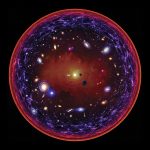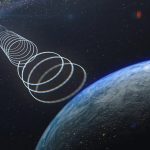A new kind of black hole analog could tell us a thing or two about an elusive radiation theoretically emitted by the real thing.
Employing a chain of atoms aligned singularly to mimic the event horizon of a black hole, a team of physicists has detected an analog of what is known as Hawking radiation – particles born from disturbances in the quantum fluctuations caused by the black hole’s break in spacetime.
This, as they assert, could potentially resolve the tension between two presently incongruent frameworks describing the cosmos: the general theory of relativity, describes gravity’s conduct as a continuous field termed spacetime; and quantum mechanics, which describes the behavior of discrete particles using the mathematics of probability.
For a unified theory of quantum gravity with universal applicability, these disparate theories must somehow harmonize.
Enter black holes – conceivably the most bizarre, extreme objects in the cosmos. These massive objects are so incredibly dense that within a certain distance to the black hole’s center of mass, no conceivable velocity in the universe ensures escape. Not even light speed.
This distance, contingent on the black hole’s mass, is termed the event horizon. Once an object crosses its boundary we can only imagine what happens, since nothing returns with vital information on its fate. However, in 1974, Stephen Hawking proposed that disruptions to quantum fluctuations at the event horizon result in a radiation akin to thermal radiation.
If this Hawking radiation exists, it’s way too faint for us to detect yet. It’s possible we’ll never sift it out of the hissing static of the Universe. But we can probe its properties by creating black hole analogs in laboratory settings.
While such endeavors are not novel, a recent effort spearheaded by Lotte Mertens of the University of Amsterdam in the Netherlands has done new findings.
A one-dimensional chain of atoms served as path for electrons to ‘hop’ from one position to another. By tuning the ease with which this hopping can occur, the physicists could cause certain properties to vanish, effectively creating a kind of event horizon that interfered with the wave-like nature of the electrons.
The consequence of this simulated event horizon manifested as a temperature escalation in alignment with theoretical projections of an equivalent black hole system, said the team, but only when part of the chain extended beyond the event horizon.
This potentially indicates that the entanglement of particles straddling the event horizon plays a pivotal role in Hawking radiation generation.
The simulated Hawking radiation exhibited thermal characteristics solely within a designated amplitude range of transitions and under circumstances simulating a ‘flat’ spacetime. This intimates that Hawking radiation may adopt thermal properties only under specific conditions, particularly amidst spacetime curvature induced by gravity.
The implications for quantum gravity remain nebulous, yet the model furnishes a means to study Hawking radiation emergence in an environment that isn’t influenced by the wild dynamics of the formation of a black hole. And, because it’s so simple, it can be put to work in a wide range of experimental set-ups, the researchers said.
“This, can open a venue for exploring fundamental quantum-mechanical aspects alongside gravity and curved spacetimes in various condensed matter settings,” the researchers write.
The research has been published in Physical Review Research.


